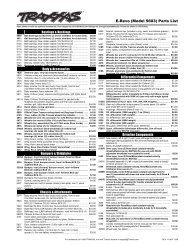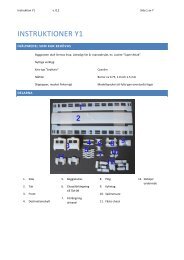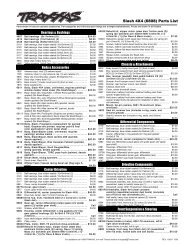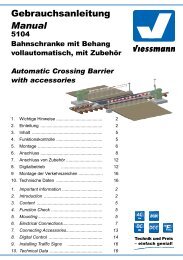ESU 51982 Manual Engelska
ESU 51982 Manual Engelska
ESU 51982 Manual Engelska
You also want an ePaper? Increase the reach of your titles
YUMPU automatically turns print PDFs into web optimized ePapers that Google loves.
Adapting the Driving Characteristics<br />
10.6.1. Linear Braking Distance<br />
CV253 = 0: The loco starts immediately to stop linearly after receiving<br />
the braking command. The brake effort is determined by the<br />
decoder so that, independent from the starting speed, the loco<br />
will stopp after reaching the way defined in CV254. The dashed<br />
line in Figure 13 shows the relation.<br />
10.6.2. Constant Linear Braking Distance<br />
CV253 > 0: Is the value in CV253 higher than 0, the locomotive<br />
continues to drive ahead for some time when entering the braking<br />
section to finally brake within the braking time indicated in<br />
CV253. The effort of the braking effect is now constant as set in<br />
CV253. The decoder changes the brake timing accordingly so that<br />
the locomotive stopps at the correct position in the end. Figure 13<br />
shows this quite clearly.<br />
10.7. Settings for Analogue Operation<br />
You can adjust the acceleration and maximum speed of the LokPilot<br />
separately for analogue DC and AC mode. Thus, you can adapt<br />
the speed of your locomotive also to analogue operations.<br />
You will have to determine suitable values by trial and error since<br />
they depend on the type of transformer (throttle) and the drive<br />
system of your locomotive.<br />
Please note that load compensation is always active ex works,<br />
even in analogue mode. This gives you smooth control even at<br />
very low speeds.<br />
10.7.1. DC Analogue Operation<br />
LokPilot V4.0<br />
LokPilot micro V4.0<br />
LokPilot V4.0 DCC<br />
LokPilot micro V4.0 DCC<br />
Speed<br />
Train A) slows down linearly: Immediately after reaching the braking<br />
point, it slows down linearly and stops at the stop point.<br />
Entry in the brake sector<br />
Train B) is fast, continues to drive<br />
only a short distance to the defined<br />
braking point, slows down and stops<br />
at the braking point.<br />
Figure 13: Constant brake distance<br />
Train C) also<br />
continues to travel to<br />
the defined braking<br />
point, slows down<br />
and stops at the<br />
same point.<br />
Desired stop point<br />
(defined by CV 254)<br />
Way<br />
In DC analogue mode you can adjust the starting speed with the<br />
CVs 125 and the maximum speed with CV126.<br />
10.7.2. AC Analogue Operation<br />
LokPilot V4.0<br />
In AC analogue mode you can adjust the starting speed with CV<br />
127 and the maximum speed with CV 128.<br />
33












